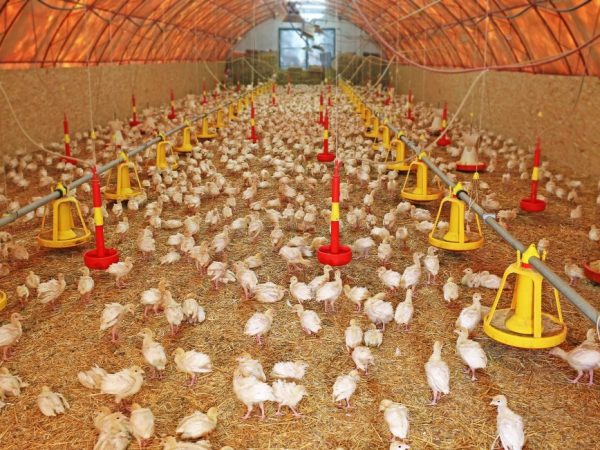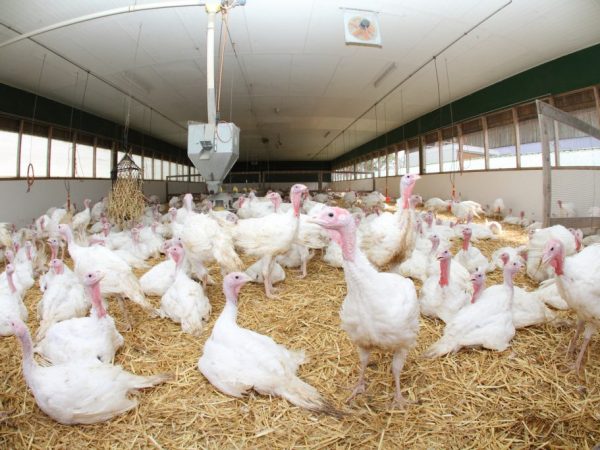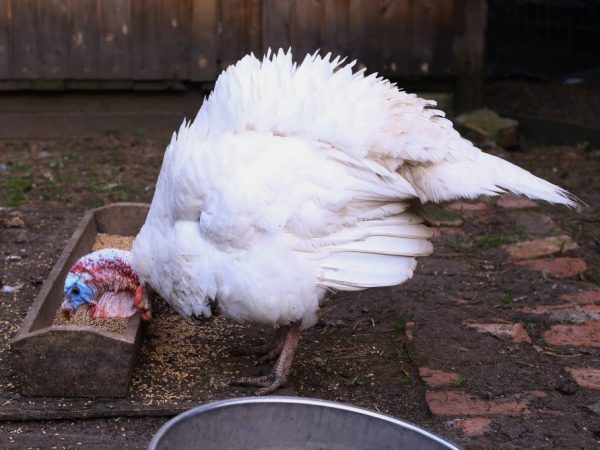How to make a do-it-yourself turkey feeder
The turkey is the unspoken leader among meat poultry breeds. However, to get the maximum amount of meat, the turkey should be fattened first. This bird must feed frequently to gain weight quickly, so the turkey feeder must be full at all times. There are store-based systems for constant feed, but you can make a similar feeder yourself. It is important to decide on the external form and materials.

DIY turkey feeder
Types of turkey feeders
Before you make a do-it-yourself feeder for chickens and turkeys, you need to decide on the type of feed. There are these types of feeders:
- Automatic hopper with a base divided into sections.
- Wooden types of box feeders.
- Automatic feed tube systems.
- Trays.
To choose the type of feeder, you should consider the following indicators:
- age and number of turkeys;
- poultry house size;
- type of feed.
In addition, the material for the building depends on the type of feed. Wet food requires metal or plastic containers, while mixed or dry foods are best stored in wooden containers.
All materials must be thoroughly disinfected before building a feed system. Large poultry have weak immunity and are easily susceptible to various diseases. The turkey feeder should keep feed from external pollution and internal decay.
Special senniks are used for grass. They can be made at home. A wooden frame is attached to the vertical surface, on which a metal mesh is pulled. On three sides, the sennik must be fixed to the frame, and from above it is filled with hay or fresh grass.
The installation of the feeder also has certain norms. The feed hole should be a couple of centimeters above the floor for the turkeys to eat comfortably. Regardless of the type of feeder, you should equip it with bumpers so that the bird does not add dirt to the food. Drinkers are often installed next to the feeder.
Features of a homemade turkey feeder
A homemade feeder for turkeys and chickens has certain advantages over a store product:
- Ease of manufacture. Drawings for many types of feeders are publicly available. In addition, there are photos and videos of various master classes.
- Individual parameters. Homemade feeders are convenient to use, since they will take into account the size of a particular poultry house when creating them.
- Minimum material costs. Usually, to create such devices, I use materials that are always at hand - boards, bottles, buckets.
Feeders trays

Feed throughout the turkey house
The tray is considered the simplest type of feeder. The feed is fully human-controlled and the grain is rarely protected from external sources of contamination.
However, mash, wet and juicy feed can only be given to birds in such structures. The hopper system is not suitable for these types of feed as the holes are instantly clogged with food.
A tray feeder for turkeys and chickens is made according to the same principle - a frame is knocked out of wooden blocks, which is fixed to a base of dense plywood. Sometimes metal or plastic is used together with wood, which deteriorate less from moisture. If such a tray is located on the street, then it will be equipped with a special canopy.
Such a structure should be washed frequently - turkeys and chickens have a habit of scooping up feed or contaminating food with straw and feathers. If you do not follow the sanitary standards for keeping, the grain will become unusable and the birds may get sick. To avoid such problems, the tray can be fixed at a height of a few centimeters from the floor.
Universal feeder for young animals
For turkeys and chickens, feeders are often built from scrap materials.
Since they need much less grain than adults, experienced poultry farmers use a special design. To build such a feeder, you need:
- A bucket for seven or ten liters.
- Bowl with sections used for dogs and cats.
- Cutting tools.
The bottom of the bucket is attached to the bowl with self-tapping screws. Small holes are made on a kind of bunker according to the number of sections. The grain is poured into an open bucket, after which the lid is firmly fixed. Under its own weight, the feed is placed in trays. Thanks to the sides and the small amount of grain, turkeys and chickens practically do not scoop out the feed. Sometimes the feeder is attached to a vertical surface a few centimeters above the ground. In this case, you should cut off the extra sections of the base. In this position, the young are unable to bring dirt into the food, and the grain itself does not damp so quickly.
A sealed plastic bucket protects the grain from moisture. However, a few small holes must be made under the lid itself, otherwise the feed may suffocate. This method is rarely used for feeding adult turkeys or chickens, since the feeder is not too large. Older individuals are given vitamin supplements with the help of such structures. In some cases, the bucket can be replaced with a plastic bottle.
Feeding tube system
This feed system is most commonly used on chicken farms. This convenient type of feeder is appreciated for its ease of manufacture and the ability to feed all poultry at the same time. In addition, little space is required to install this structure. Chicken feeder from the pipe with your own hands, it is also suitable for larger birds, if you enlarge the feed holes. For such a structure you will need:
- two plastic pipes one meter long;
- cutting tools;
- plumbing knee;
- plywood board;
- self-tapping screws.
One of the pipes is attached to a plywood base using self-tapping screws. Holes with a diameter of 100-150 millimeters are made on this workpiece. The distance between the holes must be kept in one bird's step. With the help of a bend at a right angle, a second pipe is attached, which plays the role of an automatic hopper. For better stability, it is better to secure the vertical part of the trough. Thanks to the large number of holes, turkeys and chickens will not fight for food, and the closed sides will not allow the bird to scoop out food.
If there are no tools available for cutting plastic, then you can do without holes. In this case, instead of an elbow, a tee is used, to which two pipes are connected, closing one side of the mixer with a plug. As a result, the poultry has two feed holes. Grain automatically fills the trough under its own weight. The advantage of the pipe feeder for turkeys and chickens is the material, since plastic does not allow the grain to grow with mold and does not allow moisture to pass through.A similar feeding system can be used for turkeys and chickens, but smaller pipes should be used for this.
Bunker type of feeders
This type of structure is most often built on large chicken farms, since this method of feeding poultry requires little energy from a person. The grain is poured into a special container and gradually disperse among the birds under its own pressure. Automatic chicken feeder DIY is also suitable for larger poultry such as turkeys or ducks. To make such a structure, you will need the following materials:
- Plastic pipes with a diameter of 20 and 35 centimeters.
- Wooden plank.
- 10 liter water bottle.
- Electrical tape, screws, corners, rope.
From tools for construction you will need a screwdriver, a hacksaw and a hammer. A large pipe is attached to the plywood base with the help of corners and self-tapping screws. A narrow one is installed in the center of a wide pipe. With the help of a hacksaw, oval holes of ten centimeters in diameter are cut in the plastic. It is important to keep the plastic collar in the wide tube, otherwise the birds will carry the grain to the ground. The bottom of the bottle is cut off, after which it is fixed by the throat to a narrow pipe and fixed with electrical tape. To prevent debris from getting into the bunker, the bottom is not completely cut off and used as a lid. Dry grain is poured into such feeders, since wet mash can clog the holes. For turkeys and chickens, a similar system can be used with a liter bottle. Experienced breeders recommend that beginners watch the instructional video before building this facility.
Wooden feeder

Simple and practical feeder
This design is convenient in that only one material in a larger quantity is required for construction - wood. For the product you will need:
- Base and roof made of solid wood 30x40 centimeters.
- Two racks 30 centimeters high.
- Two racks are 27 centimeters high.
With the help of self-tapping screws, the bars are attached to the board. Rear pillars should be shorter than front pillars. In this case, the roof will be at an angle and moisture will drain. If the roof slope is directed into the house, water can flood the floor of the aviary. The resulting structure is installed in a turkey poultry house or mounted to the mesh of the aviary. The main advantage of such a structure is the simplicity and low cost of materials. Also, the food will not be dampened due to good air circulation. However, it is better not to leave such a product on the street, or to equip the base with additional sills. Otherwise, the wind may scatter the food.
Remember that only dry food can be stored in wooden feeders. If you pour a damp mash into such a feeder, then the base may begin to rot. Often this open type of feeder is used to feed turkey poults and chickens in grazing.
Feeder made from a box
This corral option is suitable for open areas. The method for making such a feeder is very simple. In a medium-sized plywood box, the front side is cut with a jigsaw. The cover is attached to the three side walls with self-tapping screws. It is advisable to leave a three centimeter nut so that the turkeys do not scatter feed.
A similar design is well suited for a turkey house. However, it is better not to install such a feeder outside the pen, since the flat canopy collects moisture. To prevent the grain from becoming moldy, several holes of a couple of centimeters in diameter should be made in the side walls of the box.
The size of such a product is calculated according to the number of turkeys. Remember that hungry birds can start a fight for a place near the trough, so the box should be quite wide.
Free form feeder
Feeders for turkeys are not limited to a strict form, many farmers make them individually for an aviary or poultry house.
This method of making feeders is suitable for experienced poultry farmers, since the drawing for the future of the pen will have to be done manually. In order to correctly calculate the parameters of the feeder, you should pay attention to the following indicators:
- Number of turkeys in the house.
- Place for the trough.
- Hopper shape for grain.
- Material for manufacturing.
After calculating the dimensions of the future structure, a sketch should be made. The feeder must be airtight, materials are selected in accordance with the type of feed. The advantages of such a capacity will be the individual parameters of the pen, which can be adjusted to any poultry house. However, from the first time, not everyone can make a convenient feeder that will last a long time. There are many training videos for inexperienced poultry farmers.
Conclusion
Making a feeder for turkeys and chickens requires certain skills. Products differ in materials, construction methods and dimensions. There are types of feeders that even inexperienced poultry farmers can make. Drawings for complex structures can be found in the public domain, which also makes the task easier.
Homemade feeders have many advantages over store counterparts, however, they require certain physical costs. Experienced poultry farmers prefer bunker type feeders or free-form designs individually for the poultry house.


